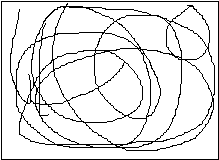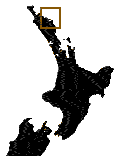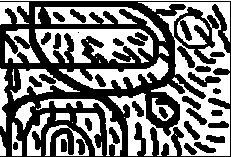Solarplate<techniques
Q. What is Solarplate?
A. Solarplate is a light sensitized steel backed polymer material used by artists as an alternative to hazardous printing techniques. It is a simple, safer, and faster approach than traditional etching and relief printing.
Q. How does it work?
A. It does not use grounds, acids or solvents. It is exposed with u.v. light (the sun) and developed with ordinary tap water.
Q. How is it done?
A. It may be done by working on the plate directly, with opaque materials in the form of non-water based pigments, or...
it may be utilized by exposing the plate through a transparent film with artwork on it. The film may be created by drawing on acetate, photocopying or scanning and printing on film, or darkroom techniques with Kodalith.
A positive transparency is for printing as an etching (Intaglio); a negative
transparency is for printing a relief impression.
Q. What etches the plate?
A. Water dissolves the unexposed portions of the plate.
Q. Who uses Solarplates?
A. Artist/printmakers, and photographers wishing to create multiple impressions of their work on quality papers. Students ranging from elementary level through college as well as professional artists.
solarplate impressions have reached the level of being exhibited in the New York's Metropolitan Museum of Art.
Q. How is the plate exposed?
A. Exposure is done by placing the transparency in contact with the plate and exposing it to the sun or placing the transparency in contact with the plate in a UV exposure box.
Q. How long should a plate be exposed?
A. Always test first...use a small plate or end cut. Exposure units vary with intensity and distance away from the light source....the sun will vary as to the time of day, season of the year, and the geographic location of the exposing source. There is pretty wide latitude of exposure time and is not critical for the single exposure.
Q. How safe is the Solarplate?
A. Safety test results reveal that SOLARPLATE causes no harm to the human body when used under normal conditions, however, the user should work in a well ventilated area to reduce any odour concentration. People with hypersensitive skin are recommended to wear gloves.
Single Exposure Intaglio and
Relief Solarplate
For Intaglio create positive drawing for Relief, negative i.e.: What you draw in black is what you wash away to make the lines. Any plate can actually be printed in Intaglio or relief but bear in mind which method you want at the start.
 |
|
Lines will print intaglio Black lines will wash out |
Surface will print in relief (or Intaglio) black will wash out leaving raised surface, (print will be opposite colour) |
Create image
- Draw on transparent film using (preferably) black opaque and semi-opaque materials:
Clear and textured films can be used and will give different effects. The final print will appear as in the drawing i.e. you draw the “right way round”.
For texture and tone:
Soft B and E pencils, litho crayon, charcoal, graphite sticks, oil crayons.
Line and marks:
Felt tips, pen and Indian ink, soft pencils
Painterly marks:
Tusche, gouache, ink, oil based paints and inks. - Alternatives:
Create image and photocopy onto acetate.
Draw onto glass (smooth or grained) to make mono type effects.
Roll ink onto film and draw through
Use digital processes to make acetate – for Intaglio create positive half tone for relief, negative.
Work directly onto the plates with oil based inks and paints. (No need to cover the plate with glass in the exposure unit with this method)
For relief print cut stencils into opaque film.
Exposure
Exposure can take place in the sun or under UV light source. It’s always a good idea to make a test strip before exposing plates, but once distance from an indoor UV light source is calibrated it should be the same for all plates of a similar size.
- Remove protective film from Solarplate
- Dust with talc to prevent sticking.
- Place film/acetate/glass with image side to plate emulsion.
- Place in exposure unit and turn on light. (Or place in sun). Exposure times will vary according to season and location – test and record times, conditions etc).
Developing
- Develop in water of between 19 – 24 degrees C – too hot will wash away emulsion!
- Scrub with soft brush and examine plate.
- Developing should take place between 3 – 5 mins.
- Blot and dry with hairdryer.
- Post harden plate in sun till emulsion completely hard.
Printing
Print as for other Intaglio or relief processes.
Reworking Solarplate
Plates can be polished with abrasives to give lighter areas, drypointed (Dremel drills are good!), engraved or have carborundum etc added.
Chine – collé techniques can be used for colour as can Createx monoprint inks.
Be wary of getting the Solarplate too wet however, as this destroys the surface
See “Printmaking in the Sun” by Dan Welden and Pauline Muir (Watson-Guptill Publications, New York 2001) for further info – it’s in the library.
Solarplate Troubleshooting Guide
What went wrong? |
Why? |
Solution |
When washing out the plate, everything washed away.
|
Insufficient exposure |
Increase exposure |
When washing out the plate, not enough washed away |
Too much exposure |
|
Plate Sticky |
Insufficient post-exposure.
|
Post-expose again. |
Not enough detail in print |
Transparency not opaque enough; Transparency upside-down. |
|
"Open-bite" effect |
Image too dense. |
|
Scratches in plate |
Washout brush may be too rough.
|
Use softer bristle. |
Water spots on plate |
Water residue not dried quickly. |
Blot immediately and dry with hair drier after washout.
|
White spots on plate |
Acetate & photocopy characteristic |
|
Black spots on plate |
Drawing dust or dirt. |
Brush transparency or clean exposure glass.
|
Drawing material transfers to plate |
India ink, certain pencils combined with pressure and heat.
|
Dust drawing with talc or baby powder. |
Circumference of plate shows irregularity in tone |
Exposure unit with vacuum frame |
|
Parts of plate are blurred or ill-defined |
Contact between plate & transparency too tight or too rigid or shifting may have occurred |
|
Plate curls when stored |
Improper storage |
Store plate w/h thin layer of oil/ kerosene in plastic; weighted with books etc. |


